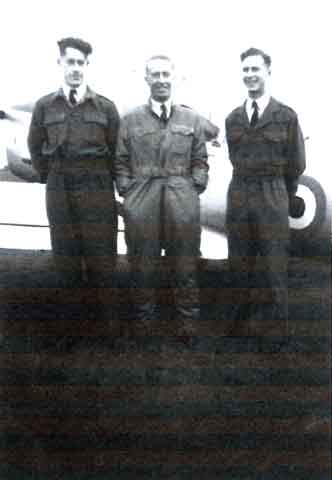
We had an emergency landing field not far away for practice purposes. We
would glide down and land, roll forward, open up, and take off again without
stopping. During one such solo exercise I came in low over the trees at one end,
landed and rolled to take off again. I had slowed too much and one of my wheels
sank into a rut in the ground, bringing me to a rapid halt, fortunately without nosing
in. I was stuck and couldn't move forward even with a fairly wide throttle opening.
So as not to be caught in that predicament I disobeyed all rules, left the engine on
tick-over, jumped out, and went to each wing tip in turn and slewed the aircraft
forward, one side at a time, so as to free the wheel from the hollow, jumped back in,
strapped up, and took off promptly.
6 I dreaded being spotted from the air and
suffering a roasting back at base, but no-one found out.

There was a low flying area not far from Belvoir Castle which we used. Low flying is as dangerous as it is exciting. We were never authorised to go below 250
feet above ground level. Instructors, although it was illegal, habitually ignored this
restriction. The ground was undulating and bracken-covered, making contours
difficult to follow. More than once a Chipmunk landed back at Desford with bracken
in its undercarriage, rapidly to be pulled off before the Chief Flying Instructor saw it.

The flying examiner, Mr Hall, was a taciturn, morose, humourless,
incommunicative individual whom none of the student pilots liked. (It was said that
if he was married his wife probably didn't like him either). He took me for my
interim flying test. That was on July 14th and I had completed 15 hours 15 minutes
dual and 10 hours 15 minutes solo. I knew what I was doing but was discomfited by
the examiner's presence in the rear cockpit. Hearing his gruff, cheerless, voice on the
intercom was no help at all. He grumpily said I had passed after we landed - a perfect three
pointer - and taxied back to dispersal; as to what marks I was awarded I have no idea.
Not everyone passed this test. Those who failed went up with the
CFI, Mr Hester, for
further assessment. As far as I can remember he failed none of our course.

The next phase of training now followed
and included cross-country navigation and instrument flying, both real and simulated.
Mr Lewin now became my instructor. My longest solo cross-country was Desford -
Wellingborough - Peterborough - Desford and took almost an hour and a half. It was
my last long distance flight on this course. I must admit that I found this sort of flying
easy and, in those days one was helped in finding large population areas because of the
heavy pall of pollution (industrial haze) over each. There were more railways then and
these greatly facilitated map reading above densely populated areas. We also practised
short take-offs and landings. It was possible to set a Chipmunk on the ground and come to a halt in something like 50 yards.

On the 12th of August I had my first night flight, dual of course. On the 14th I flew

 Myself
Myself, Mr Lewin, and Neil Davidson

who later became a well-known

competitive glider pilot.
________________________________________
6 I did not dare stop the engine because it may have needed priming to restart it which I would probably have, in
the circumstances, found impossible to do alone. I was also concerned that had I had to use the Koffman starter I
would have been a cartridge short; a fact that would have been discovered by the ground staff before the next
flight.
19








